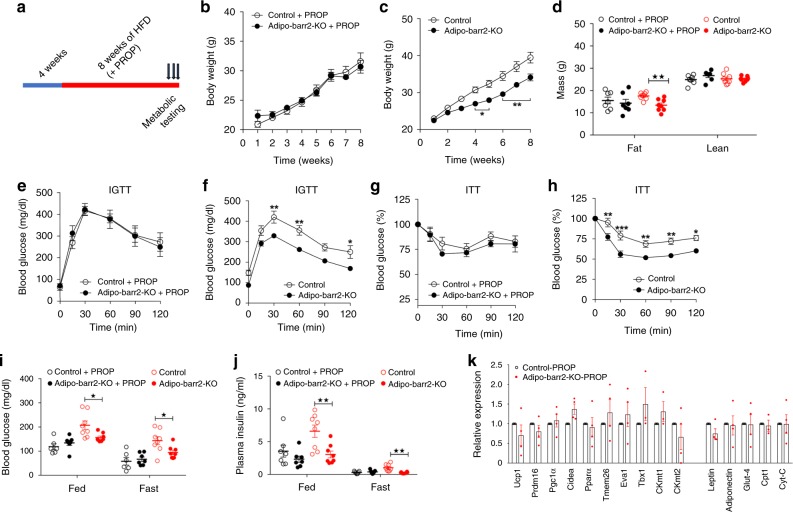Fig. 5.
In the presence of propranolol, HFD adipo-barr2-KO mice show no metabolic phenotypes. a Study design. When control and adipo-barr2-KO mice were 4 weeks old, they were maintained on a HFD at room temperature (23 °C) for at least 8 weeks. During HFD feeding, a subgroup of mice received drinking water containing propranolol (PROP) at 0.5 g/l. b, c Body weights during HFD feeding. In b, the drinking water was supplemented with PROP. In c, the mice received regular drinking water for control purposes (n = 6–8/group). d Body composition of mice consuming HFD for 10 weeks with or without PROP treatment (n = 6–8/group). e, f I.p. glucose tolerance test (1 g glucose/kg; IGTT) in PROP-treated (e) or untreated (f) mice after 8 weeks of HFD feeding (n = 6–8/group). g, h I.p. insulin tolerance test (0.75 U insulin/kg i.p.; ITT) in PROP-treated (g) or untreated (h) mice after 9 weeks of HFD feeding (n = 6–8/group). i, j Freely fed and fasting blood glucose (i) and plasma insulin (j) levels in PROP-treated or untreated mice after 8–9 weeks of HFD feeding (n = 6–8/group). k Relative transcript levels of browning/beiging marker genes and other key metabolic genes determined by qRT-PCR analysis of iWAT RNA after 12 weeks of HFD feeding of PROP-treated mice (n = 4 per group). Male mice were used for all studies. Date are shown as means ± s.e.m. *p < 0.05, **p < 0.01, ***p < 0.001 (b, c, e–h two-way ANOVA followed by Bonferroni’s post hoc test.; d, i, j two-tailed Student’s t-test)

